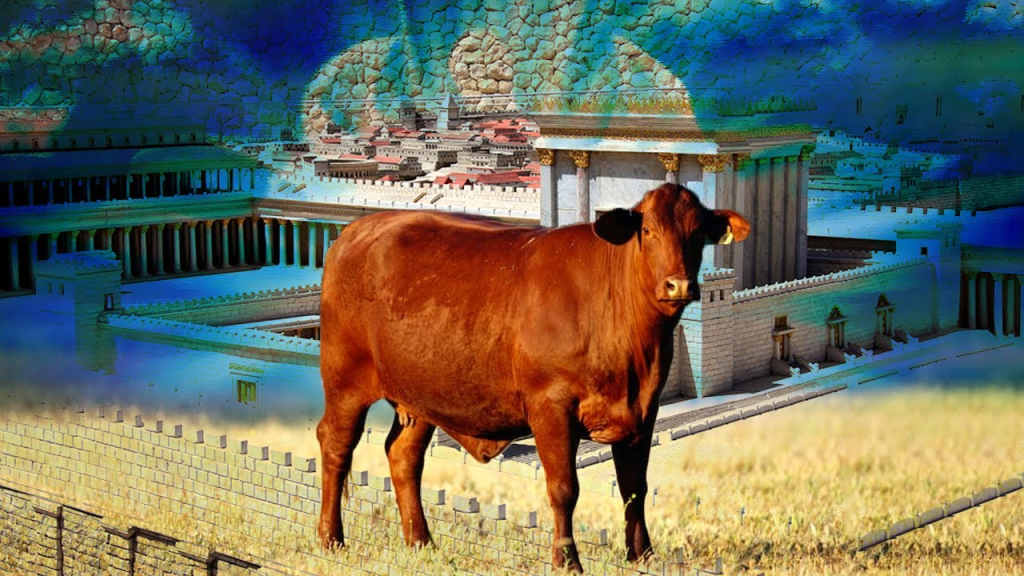The embers of ancient prophecy have been fanned once more with news of a potentially suitable red heifer identified in Israel. This specific type of cow, mentioned in the Hebrew Bible, has become entangled with notions of the apocalypse in some Christian and Jewish interpretations. But is the red heifer truly a harbinger of Armageddon, or a misconstrued relic of the past? Let’s explore this enigmatic creature through the lens of both Christianity and Islam.
The Red Heifer: A Biblical Ritual

The Book of Numbers prescribes a specific ceremony involving a red heifer. This flawless animal, “without spot or blemish, wherein is no blemish, and upon which never came yoke” (Numbers 19:2), is sacrificed and burned outside the Israelite camp. The ashes are then mixed with water to create a purification solution for certain rituals.
A Purification Rite: The Jewish Perspective
In Judaism, the red heifer ceremony is primarily understood as a method of achieving ritual purity. Contact with death rendered individuals unclean, and the heifer’s ashes were used to purify those who had come into contact with deceased bodies. This allowed them to re-enter the sacred space of the temple.
The Red Heifer and the End Times: A Christian Twist

For some Christian denominations, particularly those adhering to premillennial dispensationalism, the red heifer takes on a more eschatological significance. They believe the ashes are necessary for the purification of the Temple Mount in Jerusalem, a prerequisite for the rebuilding of the Third Temple. This reconstruction is seen as a precursor to the second coming of Christ and a period of tribulation before the final judgment.
Islam and the Red Heifer: No Direct Connection
The Quran, the holy book of Islam, makes no mention of the red heifer. Islamic eschatology focuses on different signs and events leading to the Day of Judgment, including the appearance of the Dajjal (the deceiver) and the descent of Jesus Christ.
Modern Relevance: A Ritual for a Bygone Era?

Even within Judaism, the question of whether the red heifer ritual holds practical significance in the modern world remains a point of debate. With the destruction of the Second Temple in 70 CE, the context for this ceremony no longer exists. Additionally, determining if a particular heifer truly meets the exacting biblical criteria can be a complex process.
Fact vs. Fiction: Avoiding Apocalyptic Hysteria
The internet age thrives on sensational headlines and online commentary often fueling anxieties about religious prophecies. It’s crucial to approach such claims with a critical eye and consider the following:
- Multiple Interpretations: Religious texts are inherently open to interpretation, and the red heifer prophecy is no exception. There’s no single universally accepted meaning within Christianity or Judaism itself.
- Historical Context: The red heifer ritual is rooted in a specific historical context. Understanding the customs and practices of the time is essential to interpreting its significance.
- Modern Relevance: Even if the red heifer holds symbolic meaning for some, it doesn’t automatically translate to an imminent apocalypse.
Beyond Hype: An Opportunity for Interfaith Dialogue

The red heifer discussion can be a springboard for interfaith dialogue and fostering understanding. Different faiths can explore various interpretations and delve into the historical context of the Bible.
Exploring Ancient Rituals and Religious Practices
Instead of hyper-focusing on apocalyptic narratives, the red heifer story can spark curiosity about ancient rituals and their role in religious practices. It allows us to explore how past cultures dealt with death, purity, and atonement.
A Call for Tolerance and Understanding
Discussions about the red heifer can also serve as a call for tolerance and understanding between different faiths. Respecting diverse interpretations and engaging in respectful dialogue are crucial in our increasingly interconnected world.
A Final Note: A Story with Layers, Not Doom
The red heifer is a fascinating element within the Hebrew Bible, with layers of meaning and interpretation. While some Christian interpretations see it as a harbinger of doom, it’s vital to remember that religious texts are open to discussion. Approaching this story with a spirit of exploration and understanding, rather than fear, can lead to a more nuanced perspective. The red heifer may simply be a reminder of an ancient ritual, not a sign of the end times.






GIPHY App Key not set. Please check settings